Multiple Choice
Identify the choice that
best completes the statement or answers the question.
|
|
|
The United States and Britain Join Forces
WAR PLANS Churchill & Roosevelt at White House Churchill & Roosevelt at White House | After the
attack on Pearl Harbor and America’s entry into the war, Prime Minister Churchill arrived
at the White House on December 22, 1941, and spent the next three weeks working out war plans with
President Roosevelt. Their first major decision was to make the defeat of Germany the Allies top
priority. There were several reasons for this policy
· Roosevelt had always considered
Adolf Hitler the number one enemy of the United States .
· " Joseph Stalin, whose Soviet Union was now one of the
Allies, was desperate for help against invading German forces .
· " Only after Germany was defeated could the United States
look to Britain and the Soviet Union for help in defeating Japan |
A second important decision the two leaders made was to accept
only the unconditional surrender of the Axis powers . An unconditional surrender meant that Germany
and Japan had to accept any conditions imposed by the allies. Some historians have criticized this
decision, arguing that it led Germany and Japan to fight longer and more desperately than they might
otherwise have done. The Allied leaders, however, were united in their belief that "complete
victory . . . [was] essential to defend life, liberty, and religious freedom, and to
preserve human rights and justice in their own lands as well as in other lands."
By the
end of their meeting, Roosevelt and Churchill had formed, in Churchill's words, "a very
strong affection, which grew with our years of comradeship . | | |
.
|
|
|
1.
|
Who was the leader of Great Britain in WW2, who was also a friend of FDR?
a. | Joseph Stalin | c. | Winston Churchill | b. | Charles DeGaulle | d. | Neville
Chamberlain |
|
|
|
2.
|
FDR and Churchill decided to go after Germany first. Which was not a
reason for defeating Germany first?
a. | FDR thought Hitler was a bigger threat than Japan | c. | England and the Soviets might not
help the U.S. until Germany was defeated | b. | The Soviet Union was
Communist | d. | The Soviets
needed help in defeating the Germans |
|
|
|
3.
|
Some people thought that demanding an unconditional surrender from Germany was a
mistake. Why might it be a mistake.
a. | The Axis might think they had nothing to loose by continuing to fight. This may have
made the war last longer. | c. | The Germans might give up their persecution of the Jews in
Europe | b. | Germany might get more favorable conditions in an unconditional peace
treaty. | d. | Germany and Japan
might not remain allies under an unconditional surrender plan |
|
|
|
THE BATTLE OF THE ATLANTIC  German UBoats sink Allied
ships German UBoats sink Allied
ships | 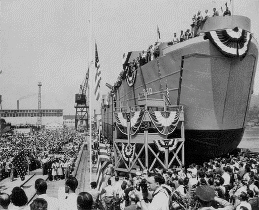 American ship building in WWII American ship building in WWII
The U.S. built ships faster than the
Germans could sink them | | |
After the attack on Pearl Harbor, Hitler
ordered submarine raids against ships along America's East Coast. Unprotected American ships
proved to be easy targets . In the first four months of 1942, the Germans sank 87 U.S. ships off the
Atlantic shore . Seven months into the year, German wolf packs had destroyed a total of 681 Allied
ships in the Atlantic. Something had to be done or the war would be lost at sea The Allies
responded by organizing their cargo ships into convoys, or groups for mutual protection, as they had
done in the First World War. The convoys were escorted across the Atlantic by destroyers equipped
with sonar for detecting submarines underwater and by airplanes that used radar to spot Uboats on the
ocean's surface . With this improved tracking, the Allies were able to find and destroy German
U-boats faster than the Germans could build them. In May 1943, Admiral Karl Doenitz, the commander of
the German U-boat offensive, reported that his losses had "reached an unbearable
height." At the same time, the United States launched a crash shipbuilding program.
Between 1939 and 1940, the United States had built only 102 ships. By early 1943, though, 140 Liberty
ships alone were being produced each month . For the first time in the war, launchings of Allied
cargo ships began to outnumber sinkings. By mid-1943, the tide of the Battle of the Atlantic
had turned in the Allies favor. A happy Churchill reported to the House of Commons that June
"was the best month [at sea] from every point of view we have known in the whole 46
months of the war."
|
|
|
4.
|
What was the greatest threat to the U.S. and Great Britain in the Atlantic in
1941 and 1942
a. | German U Boats | c. | German air raids | b. | Japanese aircraft carriers | d. | Advanced German weapons like buzz bombs and
missiles. |
|
|
|
5.
|
Why was the war in the Atlantic ocean important?
a. | American ships were supplying the allies with important war
materials | c. | War was bad for business to the countries of Europe | b. | Germany was
threatening to invade the continental United States | d. | America needed to keep the trade routes
open |
|
|
|
6.
|
How did the Allies respond to the German threat in the Atlantic
a. | increased satellite surveillance of the ships crossing the Atlantic | c. | increased our
carrier fleet in the Atlantic | b. | started shipping from South America to Europe
| d. | organized the ships into
convoys and protected them with escort ships |
|
|
|
The Eastern Front and the Mediterranean
By the summer of 1943, the
Allies began to see victories on land as well. The first great turning point came in the Battle of
Stalingrad. THE BATTLE OF STALINGRAD
The
initial German push into the Soviet Union had stalled in front of Moscow and Leningrad (now St.
Petersburg) in early 1942. With the German war machine running low on oil, Hitler changed his
tactics. He sent his Sixth Army south with two objectives: (1) to seize the rich Soviet oil fields in
the Caucasus Mountains, and (2) to capture Stalingrad (now Volgograd), a major industrial center on
the Volga River. Once the Germans controlled Stalingrad, they could cut the movement of military
supplies along the Volga River to Moscow. For three months the Germans pressed in on
Stalingrad, conquering it house by house in brutal hand-to-hand combat. By the end of September, they
controlled nine-tenths of the city-or what was left of it. In November, the Soviets launched
a massive counterattack. Hitler's military advisers begged him to order a retreat before the
Sixth Army was trapped. The Fuehrer, every bit as stubborn as Stalin, refused, shouting, "I
won't go back from the Volga." The Germans were ordered to stand and fight to the last
man
The fighting continued as winter turned Stalingrad into a frozen wasteland.
"We just lay in our holes and froze, knowing that 24 hours and 48 hours later we should be
shivering precisely as we were now," wrote a German soldier, Benno Zieser. "But there was
now no hope whatsoever of relief, and that was the worst thing of all." On February 2, 1943,
Zieser and some 91,000 other frost-bitten, lice-ridden, half-starved German troops surrendered. They
were all that was left of the army of 330,000 that had come to Stalingrad what seemed like a lifetime
ago In defending Stalingrad, the Soviets lost a total of 1,250,000 soldiers and civilians-
more than all American casualties during the entire war. Despite the staggering death toll, the
Soviets' victory on the Volga marked a turning point in the war in the east. From that point on,
the Soviet army began to move steadily westward toward Germany.
|
|
|
7.
|
Why was the Battle of Stalingrad important to the war in Europe
a. | The Americans and Russians could not join forces on the Eastern front in
Europe | c. | It was a huge lose for the Soviet Union | b. | It allowed communism
to take root in the Soviet Union | d. | It was a massive defeat for the German army and consumed huge German resources and
manpower. |
|
|
|
8.
|
Why was Germany defeated at Stalingrad?
a. | all of these | c. | Hitler’s refusal to take the advice of his
generals | b. | The bitter cold Russian winter | d. | German supply lines were stretched too
thin |
|
|
|
THE NORTH AFRICAN FRONT
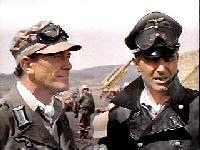 General Erwin Rommel General Erwin Rommel | 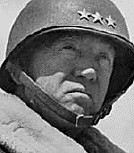 General George
Patton General George
Patton | | |
While the battle of Stalingrad raged, Stalin pressured Britain and
America to open a "second front" in western Europe. He argued that an invasion across the
English Channel would force Hitler to divert troops from the Soviet front. Churchill and Roosevelt
didn't think the Allies had enough troops. Instead, they launched Operation Torch, an invasion
of Axis-controlled North Africa, commanded by American general Dwight D . Eisenhower. In
November 1942, some 107,000 Allied troops, the great majority of them Americans, landed in
Casablanca, Oran, and Algiers in North Africa. Soon after General George Patton took leadership of
the American forces. Pattons troops and tanks sped eastward, chasing the Afrika Korps led by General
Erwin Rommel, the legendary Desert Fox. After months of heavy fighting, the last of the Afrika Korps
surrendered in May 1943. British general Harold Alexander sent a message to Churchill, reporting that
"All enemy resistance has ceased. We are masters of the North African shores ."
|
|
|
9.
|
Who was the leader of American forces in North Africa that defeated the
Germans?
a. | Erwin Rommel | c. | George Patton | b. | General Alexander | d. | General
Marshall |
|
|
|
10.
|
Who was the great German General in North Africa known as the Dessert Fox? He
was Hitters favorite general but later became involved in a plot to kill Hitler.
a. | General Franz Eisenhower | c. | George Von
Patton | b. | General Montgomery | d. | Erwin Rommel |
|
|
|
THE ITALIAN CAMPAIGN
Even
before the battle in North Africa was won, Roosevelt, Churchill, and their commanders met in
Casablanca to decide where to strike next. The Americans argued that the best approach to victory was
to assemble a massive invasion fleet in Britain and to launch it across the English Channel, through
France, and into _ the heart of Germany. Churchill, however, thought it would be safer to first
attack Italy, "the soft underbelly of the Axis." The Allies compromised. They would push
ahead with plans for the cross-channel invasion ; meanwhile, Allied troops would invade
Italy. 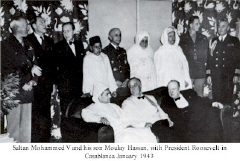 Roosevelt and Chruchill at Casablanca Roosevelt and Chruchill at Casablanca | 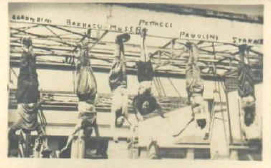 Mussolini and Mistriss
hung Mussolini and Mistriss
hung | | |
The Italian campaign got off to a good start with the capture of
Sicily in the summer of 1943 . By then, the Italians were weary of war. On July 25, 1943, King Victor
Emmanuel III summoned the Fascist dictator and prime minister Benito Mussolini to his palace and
stripped him of power. "At this moment," the king told Il Duce, "you are the most
hated man in Italy." As he left the palace, Mussolini was arrested, and Italians began
celebrating the end of the war. But their cheers were premature. Hitler responded by seizing
control of Italy, reinstalling Mussolini as its leader, and ordering German troops to dig in and hold
firm. It took 18 months of miserable fighting in the mud and mountains for the Allies to drive the
Germans from Italian soil. One of the hardest battles the Allies encountered in Europe was fought
less than 40 miles from Rome . This battle, "Bloody Anzio," lasted four months-until the
end of May 1944-and left about 25,000 Allied and 30,000 Axis soldiers dead. On April 28,
1945, partisans who had ambushed a Nazi convoy found Mussolini disguised as a German soldier in one
of the trucks . The next day, they shot Il Duce and hung his body in a Milan square. At the time of
his arrest in 1943, Mussolini had prophetically described his own fate : "From dust to power and
from power back to dust." The Allies Liberate Europe As Allied troops pushed
northward through Italy, the Soviet army moved westward into Poland. Meanwhile, in England, General
Eisenhower organized -- - Operation Overlord, the planned invasion of Hitler's "fortress
Europe ."
|
|
|
11.
|
After the defeat of Germany in North Africa, where did Churchill and Roosevelt
meet to decide where to attack Germany next.
a. | Algiers | c. | Sicily | b. | London | d. | Casablanca |
|
|
|
12.
|
Who was the Fascist Axis leader of Italy in World War II?
a. | King Emmanuel | c. | Juan Peron | b. | Erwin Rommel | d. | Benito
Mussolini |
|
|
|
13.
|
Where did the Allies begin their attack on the Axis in Italy
a. | Sicily | c. | Normandy | b. | Greece | d. | Palermo |
|
|
|
14.
|
At Casablanca the Allies had to decide how to attack Germany next. What two
places did they have to choose from?
a. | England or Italy | c. | Stalingrad or France | b. | Normandy or France | d. | Italy or France |
|
|
|
D-DAY
For two
years the United States and Britain had been building an invasion force of ships, landing craft, and
nearly 3 million troops to attack Axis forces on the other side of the English Channel.
Eisenhower hoped to take the Axis by surprise and pinpointed the relatively lightly fortified
Normandy peninsula as the focus of the assault. To make reinforcement of the German forces more
difficult once the invasion began, the Allies bombed northern France's supply routes-roads,
bridges, and rail lines-for a month and a half before the planned assault. D-Day, the day
of the invasion, had originally been set for June 5, but had weather forced a delay. Banking on a
forecast for clearing skies, Eisenhower gave the go-ahead for the next day-and June 6, 1944, became a
day that will live in history. Three divisions parachuted down behind German lines during the
night, and British, American, and Canadian troops fought their way ashore at five points along the
60-mile stretch of beach . With 156,000 troops, 4,000 landing craft, 600 warships, and 11,000 planes,
it was the largest land-sea-air operation in history. Despite the massive air and sea bombardment by
the Allies before the invasion, German retaliation was brutal, particularly at Omaha Beach.
"People were yelling, screaming, dying, running on the beach, equipment was flying everywhere,
men were bleeding to death, crawling, lying everywhere, firing coming from all directions,"
soldier Felix Branham wrote of the scene there . "We dropped down behind anything that was the
size of a golf ball." 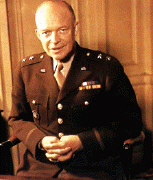 Gen Dwight
Eisenhower Gen Dwight
Eisenhower | 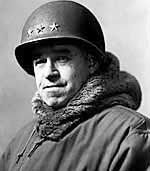 General Omar Bradley General Omar Bradley | 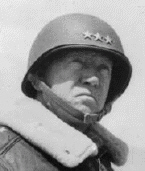 Gen George
Patton Gen George
Patton | | | |
Despite heavy casualties, the Allies held the
beachheads. Within a month, they had landed a million troops, 567,000 tons of supplies, and 170,000
vehicles in France . On July 25, General Omar Bradley unleashed massive air and land
bombardment against the enemy giving General George Patton and his Third army the gap they needed to
advance. On August 23, they reached the Seine River south of Paris . Two days later, French
resistance troops and American troops liberated the French capital from four years of German
occupation. Patton announced this joyous event to his commander in a message that read, "Dear
Ike: Today I spat in the Seine." By September 1944, the Allies had freed France, Belgium,
Luxembourg, and much of the Netherlands. This good news-and the American people's desire not to
"change horses in midstream"-helped elect Roosevelt to an unprecedented fourth term in
November, along with his new moderate running mate, Senator Harry S . Truman.
|
|
|
15.
|
What was D day?
a. | The Allied invasion of France | c. | The Allied invasion of
Germany | b. | The Allied invasion of Denmark | d. | The German invasion of
Dunkirk |
|
|
|
16.
|
What body of water did the Allies have to cross in the D Day invasion?
a. | Normandy Sea | c. | English Channel | b. | North Sea | d. | Atlantic Ocean |
|
|
|
17.
|
The D Day invasion forced the Germans to divert forces the war in _____
a. | Italy | c. | the Atlantic | b. | North Africa | d. | Russia |
|
|
|
THE BATTLE OF THE BULGE In October 1944, Americans captured their
first German town, Aachen. Hitler responded with a surprising counterattack . He ordered his troops
to break through the Allied lines and to recapture the Belgian port of Antwerp. This bold move, the
Fuehrer hoped, would disrupt the enemy's supply lines and demoralize the Allies. Also, Hitler
was devloping new weapons, such as the atomic bomb, jet planes and rockets. He thought this battle
would hold back the allies long enough for him to finish developing his new weapons. On December 16, under cover of
dense fog, eight German tank divisions broke through weak American defenses along an 80-mile front.
The resulting dent in the Allied lines gave this desperate last ditch offensive its name, the
Battle of the Bulge. As the Germans swept westward, they captured 120 American GIs near
Malmedy. Elite German troops-the SS troopers-herded the prisoners into a field and mowed them down
with machine guns and pistols . Private Homer Ford was one of the 43 who somehow
survived. 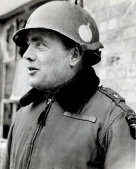 General Anthony McAuliffe General Anthony McAuliffe |
American
troops led by Brigadier General Anthony McAuliffe made a heroic stand at the Belgian town
of Bastogne. Surrounded and badly outnumbered, McAuliffe received a surrender demand from the
Germans . His reply was just one word:..............
"Nuts!"
| | |
The initial success of
the German offensive was due mainly to their ability to keep the Allies off guard. The battle raged
for a month. When it was over, the Germans had been pushed back and little seemed to have changed .
But, in fact, things had taken a decisive turn. The Germans had lost 120,000 troops, 600 tanks and
assault guns, and 1,600 planes in the Battle of the Bulge-men and weapons they could not replace .
Also, the Germans ran out of fuel and could not continue the battle. From that point on, the Nazis
could do little but retreat .
|
|
|
18.
|
What was the Battle of the Bulge?
a. | Germany’s last serious attack on the allies | c. | all of these | b. | Hitlers
counterattack against the allies | d. | A surprise attack by the German Army |
|
|
|
19.
|
Where did the German attack in the Battle of the Bulge stall
a. | the town of Bastogne | c. | Paris | b. | the town of Malmedy | d. | it did not stall, it was a German
success |
|
|
|
20.
|
What did General Anthony McAuliffe say to the Germans when they offered him
surrender?
a. | “you first” | c. | “make your offer to
headquarters” | b. | “never” | d. | “nuts” |
|
|
|
LIBERATION OF THE DEATH CAMPS
Meanwhile, Allied troops pressed eastward into the German
heartland, and the Soviet army pushed westward across Poland toward Berlin . Soviet troops were the
first to come upon one of the Nazi death camps, in July 1944. As the Soviets drew near a camp called
Majdanek in Poland, SS guards worked feverishly to bury and burn all evidence of their crimes . But
they ran out of time. When the Soviets entered Majdanek, they found a thousand "living
corpses," the world's largest crematorium, and a storehouse containing 800,000 shoes.
"This is not a concentration camp," reported a stunned Soviet war correspondent, "it
is a gigantic murder plant." The Americans who later liberated death camps in Germany were
equally overwhelmed.
|
|
|
21.
|
What did the SS do as the Allied armies advanced toward Germany and over-ran the
death camps.
a. | they tried to surrender to the Russians | c. | they tried to make friends with the
Jewish inmates | b. | they tried to cover-up what they had done | d. | they did
nothing |
|
|
|
UNCONDITIONAL SURRENDER
By April 25, 1945, the
Soviet army had stormed Berlin. As Soviet shells burst overhead, the city panicked. The Soviet
soldiers went on a killing and raping spree. In his underground headquarters in Berlin, Hitler
prepared for the end. On April 29, he married Eva Braun, his longtime companion . The same
day, he wrote out his last address to the German people. In it he blamed the Jews for starting the
war and his generals for losing it. "I myself and my wife choose to die in order to escape the
disgrace of . . . capitulation [surrender]," he said. "I die with a happy heart
aware of the immeasurable deeds of our soldiers at the front." The next day Hitler shot himself
while his new wife swallowed poison. In accordance with Hitler's orders, the two bodies
were carried outside, soaked with gasoline, and burned. A week later, General Eisenhower accepted the
unconditional surrender of the Third Reich. On May 8, 1945, the Allies celebrated V-E Day-Victory in
Europe Day. The first part of the war was finally over.
|
|
|
22.
|
What was the end of the war in Europe called?
a. | VE Day | c. | Allied Victory Day - V day | b. | Victory over Germany
Day - VD day | d. | Armistice
Day |
|
|
|
23.
|
On what date did the War in Europe end?
a. | May 8, 1945 | c. | April 2, 1945 | b. | April 29, 1945 | d. | April 8, 1945 |
|